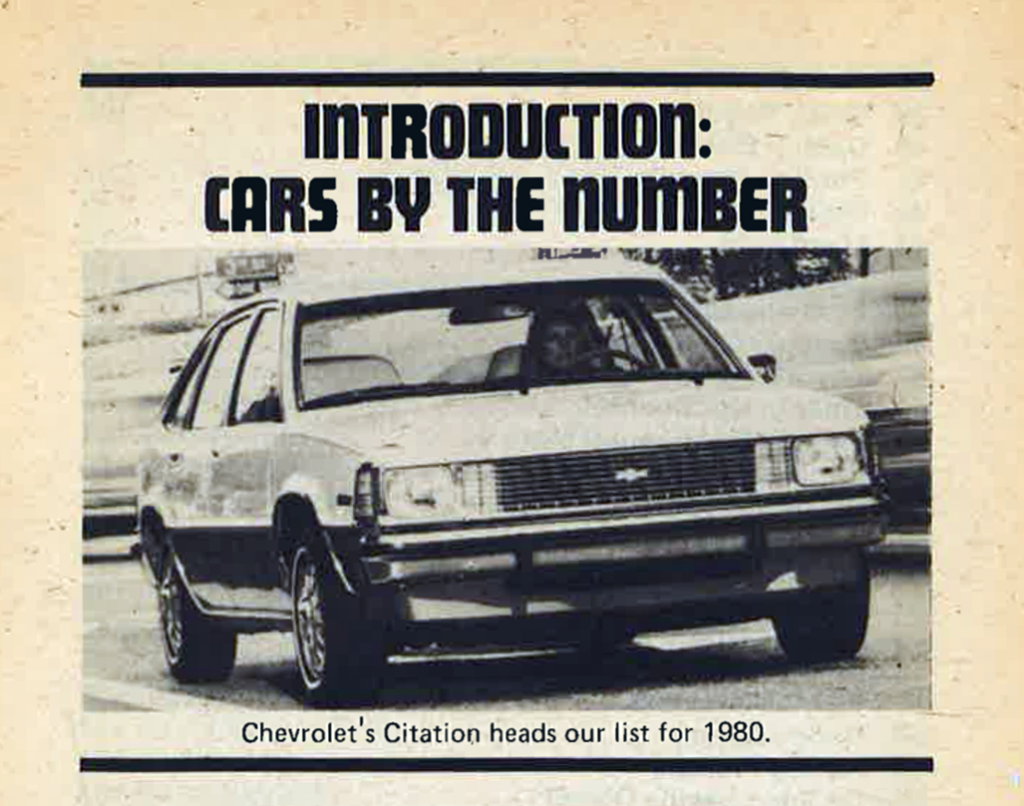
I have never read Frank Herbert’s science fiction epic Dune, but by the time I became aware that the 800-page novel was being adapted for the silver screen, I was pretty well versed on the story.
My buddy Bob had read the book in high school, and could not say enough good things about it. As it turned out, I knew several people who had dipped their literary wickets into the pool of Herbert, and all of them were crazy excited about the film. If you’re old enough, and if your memory is good, you know where this is headed: Dune the motion picture, which debuted in 1984, was an epic flop, panned by virtually every film critic of any significance.
I was crushed. I was sure I was going to be able to immerse myself in the amazing world of Dune without sitting down and turning nearly 1000 pages. For the record, I saw the movie despite the reviews, and it really was awful. And, since I did not yet know who Patrick Stewart was, his presence in the movie didn’t really do much to improve things for me.
Bad as it was, Dune was not the biggest disappointment of the Eighties, at least not for car guys. There was the Chevrolet Citation. Launched in the middle of 1979 for the 1980 model year, General Motors’ X-Car program—which included the Buick Skylark, Oldsmobile Omega, Pontiac Phoenix, and the Citation—was one of the most anticipated car launches since the Edsel (ominous comparison intentional).
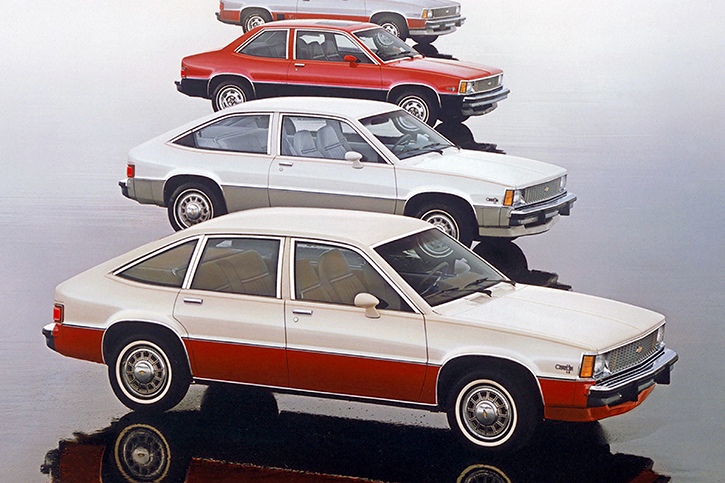
Unlike Dune, which was panned at its introduction, the X-Cars launched to incredible fanfare. The cars were design breakthroughs, and rightfully heralded for their clean and modern silhouettes, roomy cabins, spritely handling, and impressive fuel economy. The Citation especially impressed the media so well that Consumer Guide named it the best car of 1980.
Thanks in part to a massive ad campaign, the public embraced the X-Cars. Chevrolet sold an astonishing 1.2 million Citations in the car’s first two model years. But sales would fall off quickly after that.
For all of their goodness, the X-Cars were plagued with quality and design issues that were simple too critical to ignore. By the end of 1980, the X-Cars were the subject of seven recalls, all of which were troubling. Issues included:
- Leaking brake lines
- Leaking fuel likes
- Faulty seat-track anchors
- Body structure flaws
- Faulty front-strut mounts
- Transmission overheating
- Faulty steering rack
The 1980 models would be subject to additional brake recalls, one in 1981, and another in 1983.
Not surprisingly, the media picked up on the quality issues and painted GM’s new breakthrough rides as the disappointments they were—utterly destroying public confidence in the vehicles and killing sales.
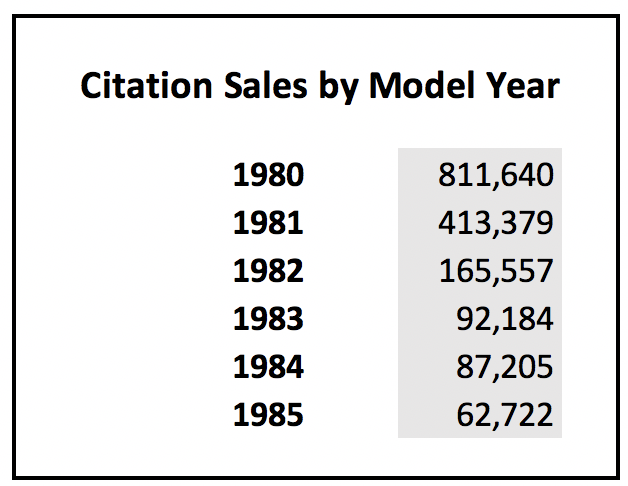 Chevrolet rebadged its X-Car Citation II for the 1984 model year, but by then the damage had been done. Chevy sold nearly 100,000 examples for ’84, which sounds healthy, but that number was a mere fraction of the volume the car saw at its debut. Worse, many of the sales were plied with substantial rebates, reducing GM’s profit margins.
Chevrolet rebadged its X-Car Citation II for the 1984 model year, but by then the damage had been done. Chevy sold nearly 100,000 examples for ’84, which sounds healthy, but that number was a mere fraction of the volume the car saw at its debut. Worse, many of the sales were plied with substantial rebates, reducing GM’s profit margins.
The Omega and the Phoenix were dropped after 1984, the Citation and Skylark after 1985.
Unique among the X-Car variants was the Citation Club Coupe, a coupe with a larger rear quarter windows and a less formal rear roofline. The Club Coupe body style proved to be relatively unpopular, and is a particularly rare sight today.
What follows is Consumer Guide’s original review of the 1980 Citation, which, though glowing, already takes note of the car’s early “teething problems.”
I wish I could tell you that I drove to see Dune in a Citation II, but I cannot. I did drive a Citation in driver’s ed, however, and recall it being especially surefooted in the snow, and easy to see out of.
If you recall spending time with any X-Car, please tell us about it. The place to leave comments is down below.
1980 Chevrolet Citation Review

Badge-Engineering Madness! 10 Classic X-Car Ads
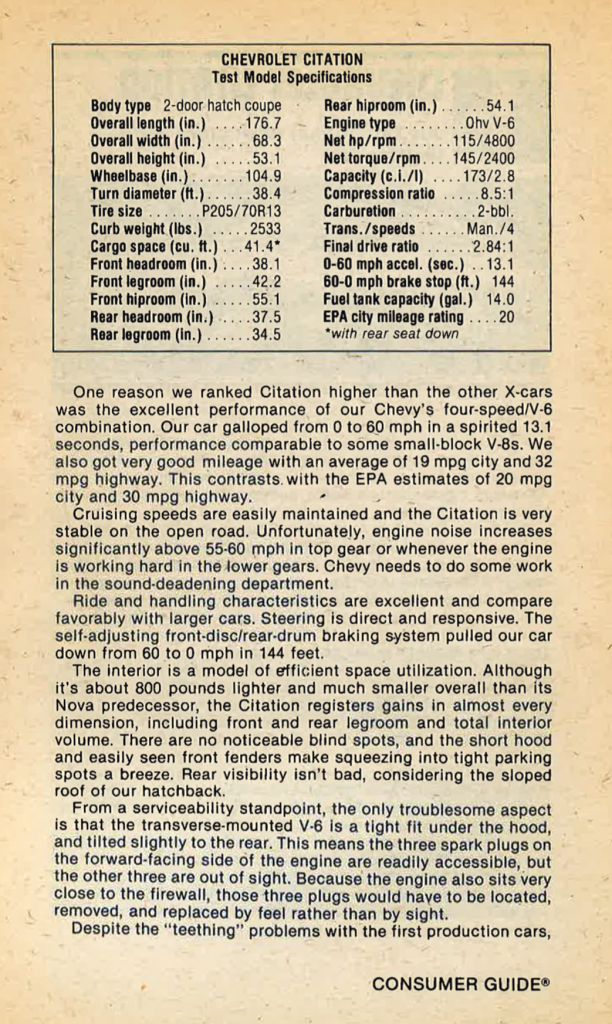
5 Cheapest American Cars of 1980, Inflation Adjusted

Model-Year Madness! 10 Classic Ads From 1980
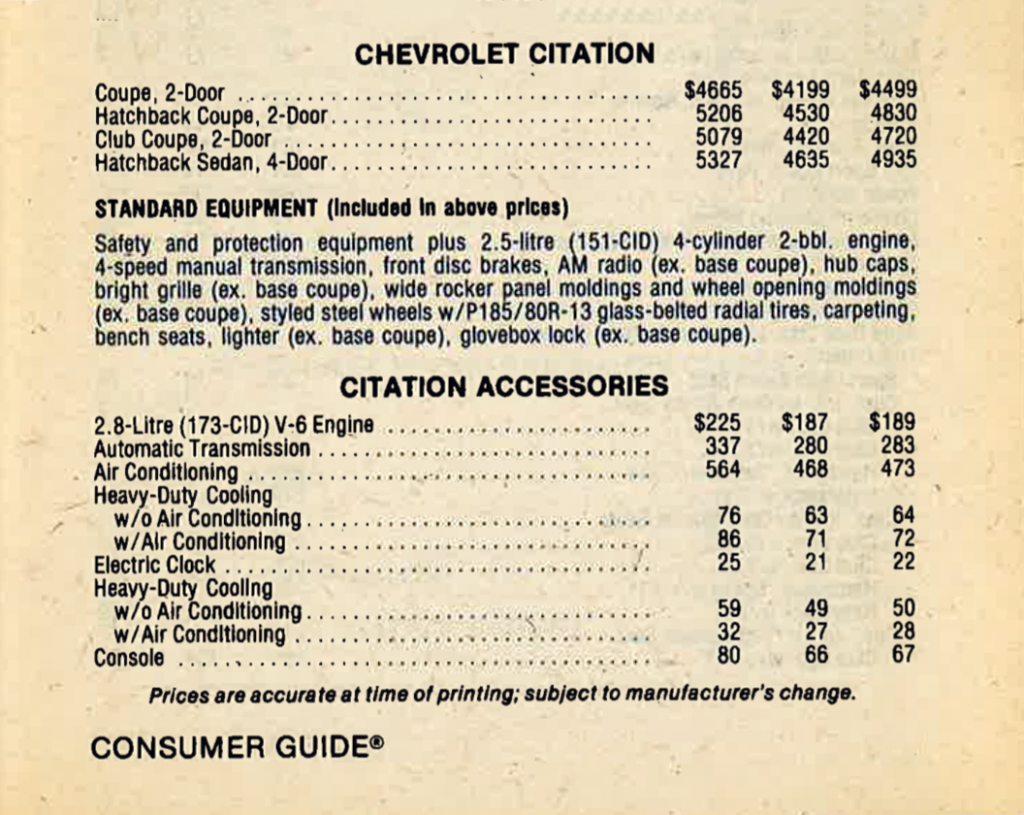
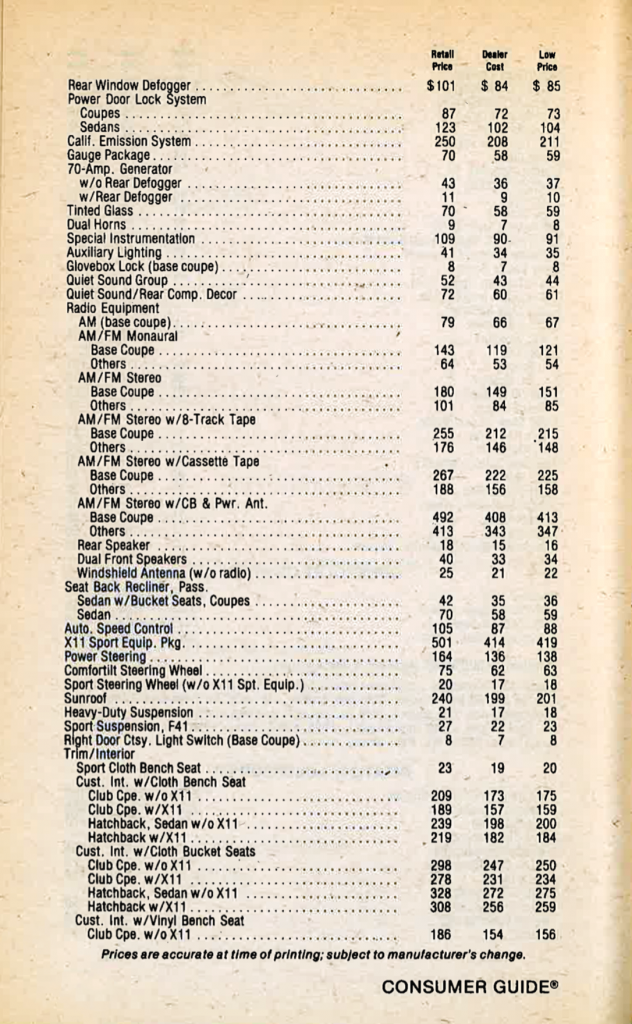
Review Flashback! 1980 Toyota Cressida Wagon
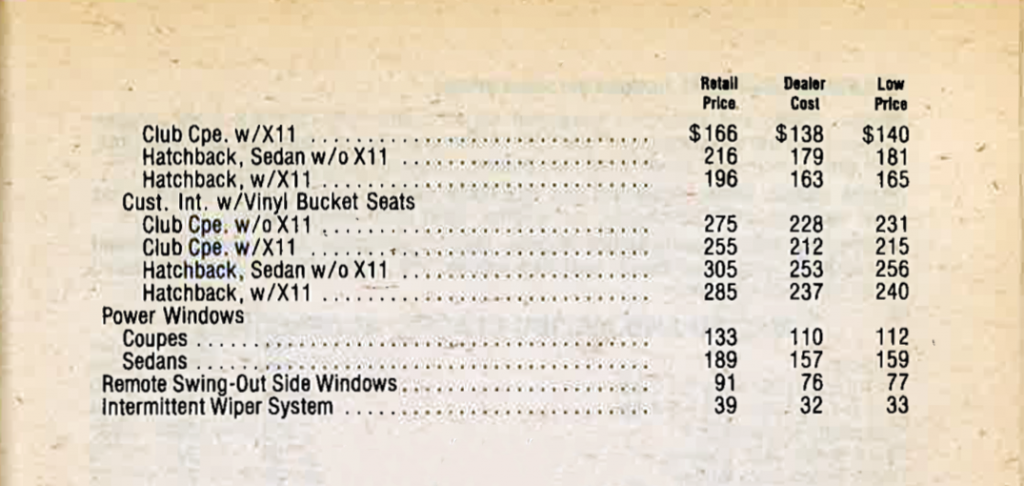
Diesel Doldrums: The 7 Slowest Cars of 1980*

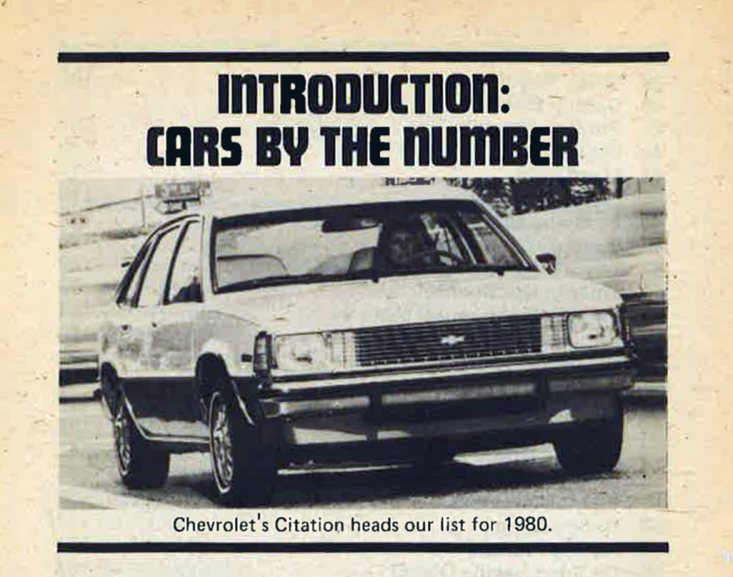

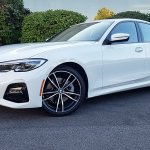
Good Afternoon. I purchased a 1980 five door hatchback from Capitol Motors in Hartford, Ct. I ordered the car for future delivery since due to the gas crisis, these cars were in huge demand. I waited over six months for the delivery and regularly walked by Capitol Motors showroom and one day, I found the Citation in body type and color I had ordered. I asked the Sales Manager about this and he confirmed that this was the Citation I ordered. He said he could not deliver it because apparently Capitol Motors has some financial problem with General Motors. I had a big deposit on the vehicle and was anxiously waiting delivery and it was a car that I liked and hall the design and nice looks of a vehicle of it’s day. Finally, Capitol Motors agreed to deliver the 1980 Citation to me. One reason for the delay in delivery was that General Motors had an contract to deliver thousands of the popular Pontiac Iron Duke four cylinder engines to American Motors. This was reputed to be a great efficient and reliable engine. My color was a green comparable to the famous “Brewster Green” of Buick fame. I found the Citation to be a well designed vehicle with MAJOR flaws in turning the engineering drawings into a useful and reliable car. On the pleasant side, the Citation delivered the stated gas mileage and it handled and rode very well and we loved the Hatchback for storing things. It handled well and was a beautiful looking car. And we wanted to support General Motors vs. the Toyotas and Hondas which were now being sold. However, we found the Citation would just stall for no reason on the road which was eventually diagnosed as an insufficient gasoline filter inside the GM carburetor. Almost immediately we noted that the parking brake would not hold on an incline since we had a standard transmission. The Citation would roll backwards or forward on an incline and almost killed my wife one day when she tried to stop it. Very dangerous vehicle unless you had an automatic transmission with a Park setting. We did use our Citation despite its fatal flaws once we understood them for a few years but wowed to never buy a poorly made GM car and haven’t done that except for another poorly constructed Pontiac Montana minivan which is a similar story of a well engineered vehicle with serious manufacturing or design flaws. I have in recent years (and I’m in my 80’s now) only purchased Toyota vehicles because of their good engineering which is converted into real world quality in their vehicles. I have had almost zero problems with my Toyotas. That’s why GM sells very few passenger cars these days including minivans with the same poor attention to build quality. Very sad, but that is my experience with General Motors which outside of trucks is in decline. And I’m sure GM will have the same poor engineering and mechanical problems with their hybrid and electric vehicles. Shame on GM and Ford is not far behind in their down hill slide. Stellantis is widely known for poor quality as well. Just read the reports.